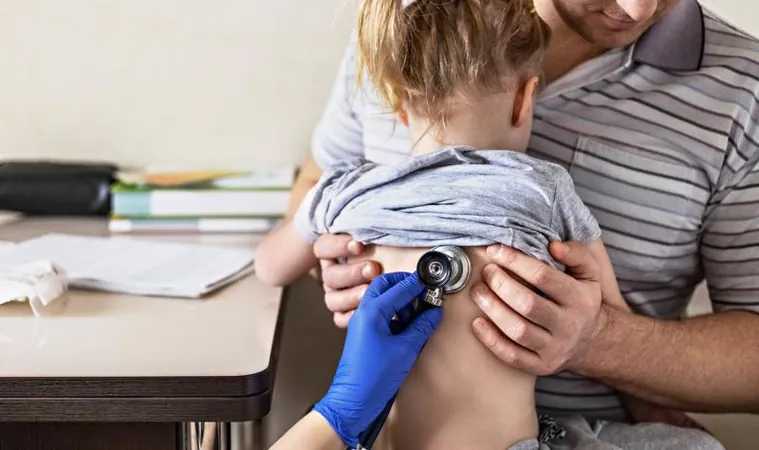
Shocking Study Reveals 20% of Children with Pneumonia are Left Without Antibiotics!
2024-10-30
Author: Yu
A groundbreaking multistate study has uncovered a startling fact: 20% of children diagnosed with pneumonia and publicly insured in the United States are not receiving antibiotics, according to researchers in JAMA Network Open. While those who lacked antibiotic treatment exhibited slightly higher rates of treatment failure, severe complications were surprisingly rare, regardless of whether antibiotics were administered.
Addressing a Clinical Conundrum
Despite the common practice of prescribing antibiotics for pneumonia, the overwhelming presence of viral triggers often leads to overtreatment. Experts suggest this is primarily due to fears surrounding potential bacterial coinfections and the lack of comprehensive studies that could guide pediatricians on when to avoid antibiotic prescriptions. Until now, no large-scale research in the U.S. has adequately assessed the outcomes between treated and untreated children.
To explore this issue, researchers dove into the Merative MarketScan Medicaid database, evaluating children under 17 diagnosed with pneumonia between January 2017 and December 2019. Antibiotic receipt was tallied based on pharmacy claims either on the day of the diagnosis or the following day. The team then compared risks of treatment failure and serious complications among those who were and weren't given antibiotics.
Key Findings from the Data
Among the 103,854 children analyzed, the average age was 5, with a gender distribution of 52.6% males and 47.4% females. Out of this group, a striking 80.3% received antibiotics, while about 19.7% did not. Notably, urgent care centers and outpatient clinics showed higher rates of antibiotic prescription compared to emergency departments. Disparities were also evident based on race, as non-Hispanic Black children received antibiotics less frequently compared to their non-Hispanic White and Hispanic counterparts.
In a more detailed analysis involving 40,454 children—20,277 from each treatment group—treatment failure was observed in 10.7% of children not treated with antibiotics compared to 8.7% of those who received them. Moreover, severe outcomes occurred in 1.1% of the untreated group versus 0.7% of those treated with antibiotics. While these differences were present, the actual rates of severe outcomes were low in both groups, suggesting the potential for safe management of pneumonia without immediate antibiotic intervention.
Looking to the Future
Interestingly, further analysis indicated that the risk of treatment failure among children not receiving antibiotics decreased when excluding those with asthma or bronchiolitis. This invites questions about generalized treatment protocols and the need for tailored approaches to pediatric pneumonia cases.
Despite its limitations—mainly that it focused on Medicaid-insured children and could not capture all instances of both prescribed and unprescribed antibiotic use—the study is a call to action. Its findings highlight the necessity of identifying which pediatric pneumonia cases can be effectively managed without resorting to antibiotics, a revelation that could reshape treatment practices.
With more than 100,000 children analyzed, the implications of this research may lead to significant changes in how pneumonia is treated in children. Future studies will need to focus on specific demographics and situations that warrant antibiotic use, possibly decreasing the reliance on these medications and addressing the growing concern of antibiotic resistance—a critical issue for public health.
As the medical community grapples with these findings, parents and caregivers may wonder: when is it safe to say no to antibiotics for their children struggling with pneumonia? The answer could redefine treatment standards and protect our children’s health in essential ways. Stay tuned for more updates on this ongoing conversation in pediatric health!


 Brasil (PT)
Brasil (PT)
 Canada (EN)
Canada (EN)
 Chile (ES)
Chile (ES)
 España (ES)
España (ES)
 France (FR)
France (FR)
 Hong Kong (EN)
Hong Kong (EN)
 Italia (IT)
Italia (IT)
 日本 (JA)
日本 (JA)
 Magyarország (HU)
Magyarország (HU)
 Norge (NO)
Norge (NO)
 Polska (PL)
Polska (PL)
 Schweiz (DE)
Schweiz (DE)
 Singapore (EN)
Singapore (EN)
 Sverige (SV)
Sverige (SV)
 Suomi (FI)
Suomi (FI)
 Türkiye (TR)
Türkiye (TR)